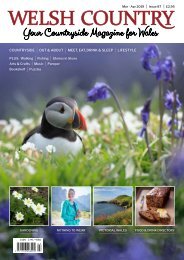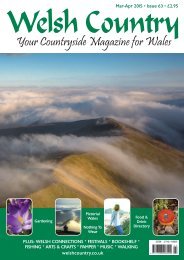Welsh Country - Issue93 - Mar-Apr 20
Create successful ePaper yourself
Turn your PDF publications into a flip-book with our unique Google optimized e-Paper software.
Four Thousand Years
Is Not A Long Time
Coetan Arthur, Arthur’s Quoit, stands on St David’s
Head, where Wales meets the western sea. It’s 4000
years since neolithic people devoted themselves to
making this mark, here, in their community. It’s one of the
oldest buildings in the world, older than the pyramids. What
is left of the tomb is construction of bare stone. I want to
discover whether any trace of the meaning of this ancient
place remains.
I get my first view as I reach the top of a small rise in
the path above Porth Melgan. Coetan Arthur is still about
a quarter of a mile away, in a saddle formed by a dip in
the cliffs, between two rock outcrops. Within yards of
leaving that small undulation, it is lost from view. To see
it again I have to walk up a steep slope, until it is revealed
as the ground unfolds to a small plateau. Here the grass is
smoother and freer of boulders. Two lines of stone reach out
from the entrance, beckoning me in. Behind it the land rises
just enough to keep the chamber below the horizon, before
the earth drops steeply to the waves. Rocky outcrops strewn
with boulders hide it from the south and the north.
The full collective energy of a community would have
been needed to make this structure. The capstone, measuring
four by three metres is half a metre thick. It rests on the
ground on one side and is supported on the other by
an orthostat, an upright pillar of rock, one and
a half metres tall. Two other orthostats lie
on the floor. The capstone’s slab of
smooth gabbros rock sparkles
in this afternoon’s sun.
Its not, the harnessing of physical energy that impresses
me most. It is a building that is concealed and revealed as
you move through the landscape. The effect is intimacy on
a windswept headland. That needed forethought, by people
who must have known how to use space and lines of sight.
They must have understood that moving through the land
shifts shape and vista and through them how power and
emotions can be channeled. An idea, an expression of belief
is created, a landscape is sculptured. I don’t know what they
called that. We call it art.
I want to get some sense of how the tomb feels, whether
it is still capable of speaking to me. Bending low, I clamber
into the now empty space beneath the capstone, into the
chamber that would have held the human remains. It is
barely a two metres wide and four metres in length. The
stones, dense and heavy, press in around me. Nothing
grows in here. The floor is hard,
dry and strewn with small
pebbles. There’s no
room to turn
14
www.welshcountry.co.uk









